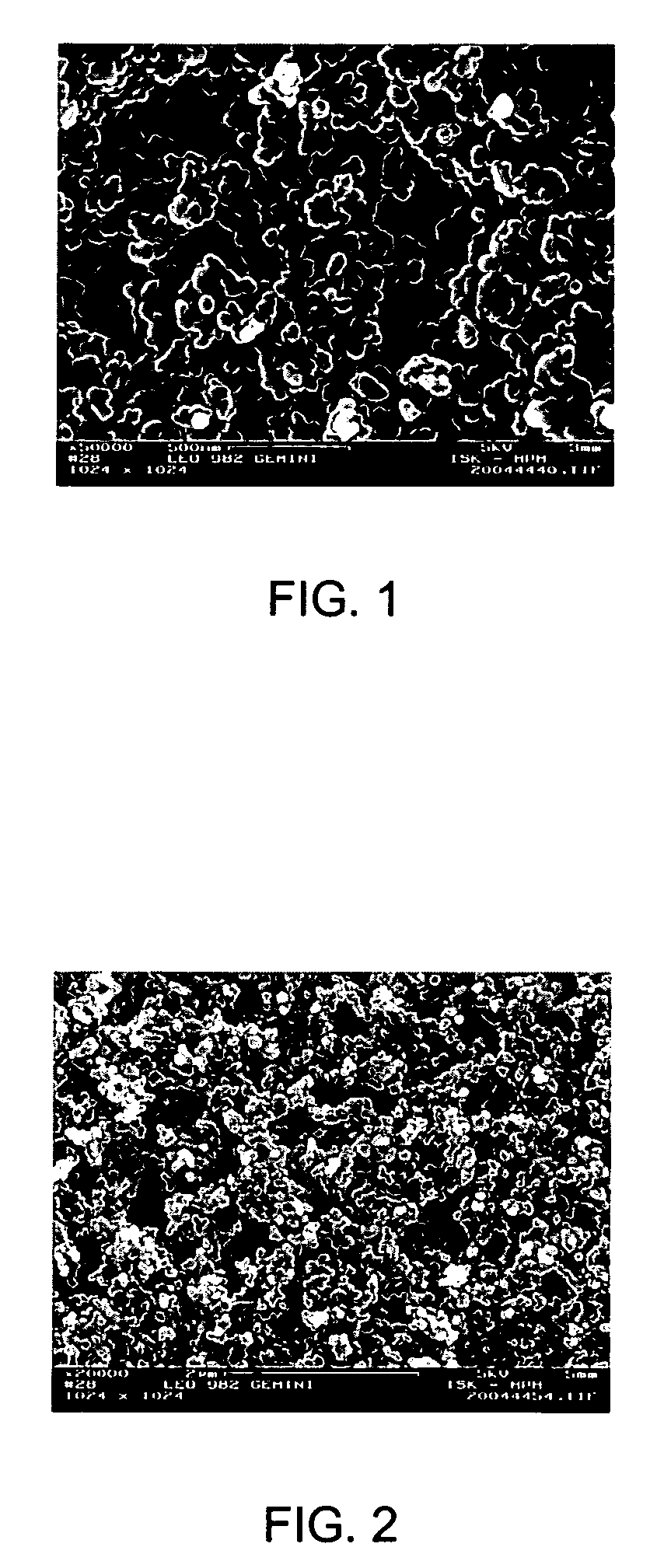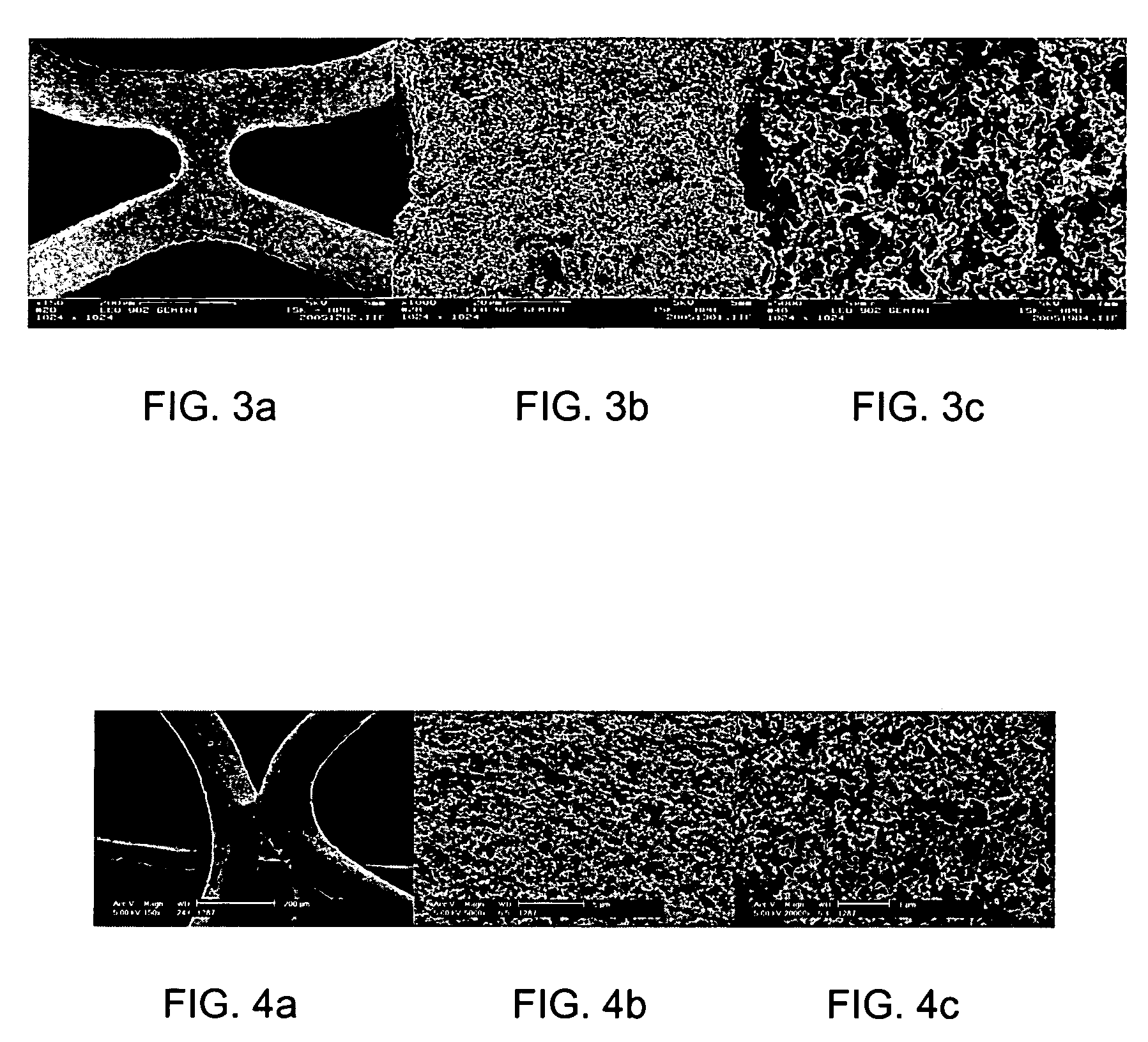Medical devices comprising a reticulated composite material
a composite material and medical device technology, applied in the field of medical devices, can solve the problems of reducing the available surface in porous materials, difficult control of pore sizes, and insufficient tailoring of mechanical properties
- Summary
- Abstract
- Description
- Claims
- Application Information
AI Technical Summary
Benefits of technology
Problems solved by technology
Method used
Image
Examples
example 1
[0216] A homogeneous dispersion of soot, lamp-black (Degussa, Germany) having a primary particle size of about 90 to 120 nm in a phenoxy resin (Beckopox® EP 401, Cytec) was prepared using the following exemplary procedure. First, a parent solution of methylethylketone (31 g), 3.1 g Beckopox® EP 401 and 0.4 g of glycerin (Sigma Aldrich) (a cross linker) was prepared. A soot paste was prepared using 1.65 g Lamp Black and 1.65 g of a dispersing additive (Disperbyk® 2150, solution of a block copolymer in 2-methoxy-1-methylethylacetate, Byk-Chemie, Germany), and adding a portion of the methylethylketone / Beckopox® EP 401 parent solution. Subsequently, the paste was converted into a dispersion by adding the remaining parent solution using a Pentraulik® dissolver for 15 minutes to obtain a homogeneous dispersion.
[0217] The dispersion was observed to contain a total solids content of about 3.5%, which was determined using a humidity measurement device (Sartorius MA 50). The particle size di...
example 2
[0219] A homogeneous dispersion in a phenoxy resin was prepared as described in Example 1. However, 1.6 g of silica (Aerosil R972, Degussa, Germany) was used instead of soot. The dispersion was observed to have a total solids content of about 3.2%, and the average particle size distribution was D50=150 nm. The dispersion was sprayed onto a steel substrate to an average areal weight of 3.3 g / m2 and dried with hot air for 2 minutes. A thermal treatment was then performed on this sample under the same conditions described in Example 1.
[0220] The resulting porous composite layer produced in this example is shown in the scanning electron microscopy image of FIG. 2 at 20,000× magnification. The sample was observed to have an average pore size of about 150 nm.
example 3
[0221] A homogeneous dispersion of soot, lamp-black (Degussa, Germany) having a primary particle size of 90 to 120 nm, and fullerenes (Nanom Mix, FCC) and a phenoxy resin (Beckopox® EP 401, Cytec) was prepared using an exemplary procedure similar to the procedure described in Example 1. First, a parent solution of methylethylketone (31 g), 3.1 g Beckopox® EP 401 (resulting in a solids content of about 50%) and 0.4 g of glycerin (Sigma Aldrich) as a cross linker was prepared. A paste of the reticulating particles was prepared from 0.9 g lamp black, 0.75 g of the fullerene mixture and 1.65 g of a dispersing additive (Disperbyk 2150, Byk-Chemie, Germany), and a portion of the methylethylketone / Beckopox® EP 401 parent solution was added. Subsequently, the paste was converted into a dispersion by adding the remaining parent solution using a Pentraulik® dissolver for 15 minutes to obtain a homogeneous dispersion. The dispersion had a total solids content of about 3.6% (by weight), which w...
PUM
| Property | Measurement | Unit |
|---|---|---|
| pore size | aaaaa | aaaaa |
| pore size | aaaaa | aaaaa |
| pore size | aaaaa | aaaaa |
Abstract
Description
Claims
Application Information
 Login to View More
Login to View More - R&D
- Intellectual Property
- Life Sciences
- Materials
- Tech Scout
- Unparalleled Data Quality
- Higher Quality Content
- 60% Fewer Hallucinations
Browse by: Latest US Patents, China's latest patents, Technical Efficacy Thesaurus, Application Domain, Technology Topic, Popular Technical Reports.
© 2025 PatSnap. All rights reserved.Legal|Privacy policy|Modern Slavery Act Transparency Statement|Sitemap|About US| Contact US: help@patsnap.com



